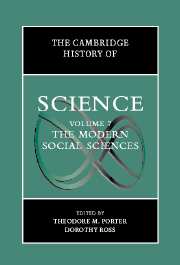Book contents
- Frontmatter
- 1 Introduction: Writing the History of Social Science
- PART I SCIENCES OF THE SOCIAL TO THE LATE NINETEENTH CENTURY
- PART II THE DISCIPLINES IN WESTERN EUROPE AND NORTH AMERICA SINCE ABOUT 1880
- PART III THE INTERNATIONALIZATION OF THE SOCIAL SCIENCES
- PART IV SOCIAL SCIENCE AS DISCOURSE AND PRACTICE IN PUBLIC AND PRIVATE LIFE
- 30 The Uses of the Social Sciences
- 31 Managing the Economy
- 32 Management and Accounting
- 33 Polling in Politics and Industry
- 34 Social Science and Social Planning During the Twentieth Century
- 35 Social Welfare
- 36 Education
- 37 The Culture of Intelligence
- 38 Psychologism and the Child
- 39 Psychiatry
- 40 Gender
- 41 Race and The Social Sciences
- 42 Cultural Relativism
- 43 Modernization
- Index
- References
41 - Race and The Social Sciences
from PART IV - SOCIAL SCIENCE AS DISCOURSE AND PRACTICE IN PUBLIC AND PRIVATE LIFE
Published online by Cambridge University Press: 28 March 2008
- Frontmatter
- 1 Introduction: Writing the History of Social Science
- PART I SCIENCES OF THE SOCIAL TO THE LATE NINETEENTH CENTURY
- PART II THE DISCIPLINES IN WESTERN EUROPE AND NORTH AMERICA SINCE ABOUT 1880
- PART III THE INTERNATIONALIZATION OF THE SOCIAL SCIENCES
- PART IV SOCIAL SCIENCE AS DISCOURSE AND PRACTICE IN PUBLIC AND PRIVATE LIFE
- 30 The Uses of the Social Sciences
- 31 Managing the Economy
- 32 Management and Accounting
- 33 Polling in Politics and Industry
- 34 Social Science and Social Planning During the Twentieth Century
- 35 Social Welfare
- 36 Education
- 37 The Culture of Intelligence
- 38 Psychologism and the Child
- 39 Psychiatry
- 40 Gender
- 41 Race and The Social Sciences
- 42 Cultural Relativism
- 43 Modernization
- Index
- References
Summary
Over the last two centuries, race has carried contradictory meanings to members of different racial and ethnic groups and conveyed distinct and separate symbols even within such groups. Unlike the distinction between gender (social) and sex (biological), race connotes both categories. It conveys a cultural political entity that has certain, if not specific, relations to a group’s image of its own primordial characteristics. The mid nineteenth-century belief that “race is everything” was capacious and ill-defined, yet it provided an overarching concept that included meanings both natural and cultural, scientific and popular. Race has long played a powerful popular role in explaining social and cultural traits, often in ostensibly scientific terms. Furthermore, the confusion about race is heightened by the popular illusion, often shared even by scientists, that in premodern times racial distinctions were more orderly and clear, as communities and identities were coherent. This romantic view assumes a stable racial antiquity in contrast to the dynamic, hybrid racial anarchy of modern times. While the idea of race implies a permanent biological entity, an historical overview shows that the meaning of race is provisional and has changed according to political and social circumstances. A close relative of the concept of “race” is “racism,” and the two are often confused. Racism, in contrast to the specific and changing content of theories of race, is an ideology of hatred of the Other, and is used as a derogatory term. It was introduced into English from German in 1938, and replaced the word racialism, which had been used to denote a hierarchical view of races but which lacked the stigma of “racism.”
- Type
- Chapter
- Information
- The Cambridge History of Science , pp. 693 - 707Publisher: Cambridge University PressPrint publication year: 2003
References
- 4
- Cited by

